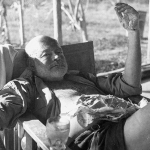“It was a brilliant cure, but we lost the patient,” Ernest Hemingway said in 1961 following 15 electroshock treatments. “Released in ruins,” according to one account, Hemingway went home, put a shotgun in his mouth and blew the top of his head off.
Ulf Wolf – a freelance writer – told me recently that in 1968 he worked in a mental hospital in Sweden but was fired for helping patients escape. On the 100th anniversary of Ernest Hemingway’s birth, Ulf read an article about Hemingway’s depression, shock treatment and suicide.
Drawing on his own experience as a mental institution nurse, Ulf wrote a fictional story about Ernest Hemingway’s shock treatment and suicide, that is as gritty and raw as one of Hemingway’s own. It contained for me the horror of one of the world’s most skilled writers seeing his creativity engulfed by darkness.
“I’m all dark inside,” says the fictional Hemingway to the nurse in Ulf’s story. “It is like a morgue in here. You’ve welded me shut with your electric machine, and my head won’t let me out anymore. I can’t remember things, I can’t imagine things … Please, John. That’s all I have. My memory and my imagination are all I have. My imagination is the light I see by when I write … There’s no light now. I have no light. Nothing to see by.”
You can read “I Killed Hemingway” free on Ulf’s website, download it for free in various formats on smashwords or to thank him for caring and for letting those inmates escape, buy it from Amazon for 99 cents .


